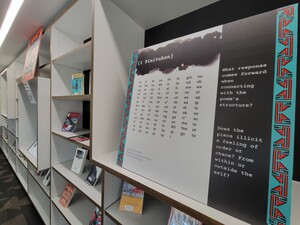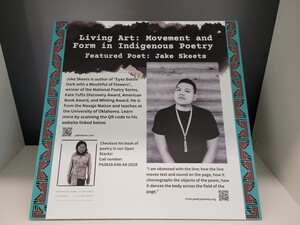
Importance of Poetry Works from Indigenous People
So much can be said about why works of poetry are key to understanding who we are as Indigenous people. These specific works are a reclamation of our lived experience. They serve as a testament to who we are and our resilience that has remained steadfast in spite of all odds. This is a key component of consideration, as so much of written history has sought to erase us from the annals of humanity, to no avail. Poetry is our weapon. Revered, praised, and often imitated, Indigenous poetry builds patterns around the collective Native experience and the theme of balance. The act of walking the tightrope of living between two worlds, remaining traditional within a modern landscape, and fighting for defiant visibility in a world that is and has historically attempted to erase our existence. Poetry acts as a form of resistance for some, and as a way of retelling experiences for others. When one thinks of poetry, the reader immerses themself in the unfolding story and, in the case of Indigenous poets, we see ourselves as who we were, who we currently are, and who we aim to be. - Tait Wilson (Tohono O'odham and Black)
Living Art: Form and Movement in Indigenous Poetry Labriola Book Display
The Labriola National American Indian Data Center has a book display that highlights Indigenous poetry using visual components, such as form, color, shape, and arrangement, to convey our eclectic experience as Indigenous peoples, which is succulently outlined above by Tait. The Book Display title, “Living Art: Movement and Form in Indigenous Poetry” is rooted in our identity, sitting in conversations with land, culture, kinship, and language. The phrase “Living Art” emboldens our positionality as Indigenous scholars and writers in the creative writing field, that we are not of the past but very much living and in the present. This Book Display honors our artistry as Indigenous writers and poets, and, more importantly, as humans.

For the design of the sign, I wanted to incorporate the beautiful rug design Randy L. Barton (Diné) created for the Labriola. Something I've enjoyed creating throughout my life are collages, and to me, the Labriola Center is a collage of tribal nations: each a unique part of a larger Indigenous community. Randy's rug design is bold and bright, bringing me feelings of pride and joy being an Indigenous person. The title, "Living Art" is in conversation with the rug's bright colors, colors of unyielding presence and joy. The rug design weaves pixels within a lined backdrop composed of corn pollen yellow, hibiscus orange, and low burning red. For the supporting Book Display signs, I used the blue and red frame around the rug design to incorporate rhythm into the book display. The black columns along the right of the signs capture the weight of the questions asked regarding visual poems. The ink patterns over the titles remind me of clouds, with each title spilling words, like rain, over the white space of the page. I wanted to fill the white space with the bodies of letters and words spoken by Indigenous peoples. I also have a heart in the Open Mic Poetry Night, as it is a community space where Indigenous people can express their experience through poetry. I wanted to ensure the display embodied that spirit I feel in our fellow American Indian poets.

Tait, in addition to writing the intro, helped write thoughtful questions for audiences to read and reflect upon. He helped decide on the graphics, picked out the books within the display, and chose the visual poems "In the Fields," "Naked," and "I Tinituhan" to be featured in our Book Display signs. The poetry’s purpose is to make you think differently about shape and text on the page. For "I Tinituhon'' by Craig Sanoz Perez (New Poets of Native Nations, Joy Harjo, call number: PS591.I55 N49 2018), there is depth and breath within its shape that makes you take pause and reflect. Reading this piece taught me to read each word with patience. His other picked poetry was Jake Skeets' poem, "Naked." This poem made me think about Indigenous masculinity, how blood and lust are real experiences for Native men. Each sign contains a question for the audience to engage with. Tait's intriguing questions about the visual components of each piece creates an interactive experience. I especially loved his question for whether "I Tinituhon" elicits feelings of order or chaos, and if so, he encourages you to explore your relationship with the piece further.

Jake Skeets (Diné) is our featured Indigenous poet, who uses visual poetry within his work and teaching. His book, “Eyes Bottle Dark with a Mouthful of Flowers” evokes historical ties to land and kinship in a landscape that is very violent. Gallup, New Mexico is a historical border town along Route 66, bordering the Navajo Nation, and is a hub for tourism, artists, and jewelers. However, Gallup, is also a hub for violence: many homeless Indigenous people are found dead every year on the streets and in the fields surrounding Gallup. Jake's book was winner of the 2021 Kate Tufts Discovery Award, the 2020 Whiting Award in Poetry, and finalist for the 2020 Lambda Literary Award in Gay Poetry. The sculpture of his poems embody the brutality and beauty in landscapes, in the love and blood between men who cannot show tenderness in the open, men who are hunted at night and found dead in the open elements. Jake Skeets will be hosting this spring semester’s Open Mic Poetry Night and facilitating a poetry workshop based on visual sovereignty. His book is in our Open Stacks at both Labriola Centers and can be checked out with a valid ASU ID card. Take some time this semester to check out his book of poetry by going to the Book Display on the 2nd floor of Hayden Library or check out the Open Stacks at the Labriola Center in Fletcher Library. - Yitazba Largo-Anderson (Diné)
Indigenous Open Mic Poetry Night Event: https://asuevents.asu.edu/event/indigenous-open-mic-poetry-night


